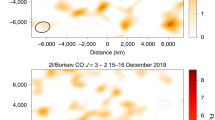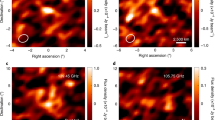Abstract
Comets probably contain the most primordial material in the Solar System, and those which are passing through the inner Solar System for the first time are likely to be the most pristine of all. Comet Bowell (1982 I = 1980b) was discovered in 1980 at the unusually large heliocentric distance of R = 7.3 AU (ref. 1). The small reciprocal of the original orbital semi-major axis, (1/a) = 30 × 10−6 AU−1, suggests that this comet is dynamically new in the sense that it has made few, if any, previous passages through the inner Solar System2. Because prolonged solar irradiation may alter the properties of short-period comets, it is of great interest to see if 1982 I exhibits properties which are significantly different from those of the periodic comets. We present new observations of comet Bowell at the record distance R = 13.6 AU. An extended coma is present, the size of which is consistent with the same slow expansion rate v ≈ 1 m s−1 detected around perihelion (March 1982 and R ≈ 3.36 AU). The cross-section of the solid grains within the central 10 arc s of the coma has decreased by over an order of magnitude since 1980–1984, which indicates that the coma production is declining. The decline began near R ≈ 10 AU, the same distance at which production began on the pre-perihelion leg. The coma at R ≤ 10 AU may be formed by sublimation of CO2 or an ice of similar volatility from the nucleus.
This is a preview of subscription content, access via your institution
Access options
Subscribe to this journal
Receive 51 print issues and online access
$199.00 per year
only $3.90 per issue
Buy this article
- Purchase on Springer Link
- Instant access to full article PDF
Prices may be subject to local taxes which are calculated during checkout
Similar content being viewed by others
References
1. Bowell, E. IAU Circ. No. 3465 (1980). 2. Everhart, E. & Marsden, B. G. Astr. J. 93, 753–754 (1987). 3. Meech, K. J., Jewitt, D. & Ricker, G. R. Icarus 66, 561–574 (1986). 4. Campins, H., Rieke, G. H. & Lebofsky, M. J. Nature 301, 405–406 (1983). 5. A'Hearn, M. R, Dwek, E. & Tokunaga, A. T. Astrophys. J. 282, 803–806 (1984). 6. Jewitt, D. C., Soifer, B. T., Neugebauer, G., Matthews, K. & Danielson, G. E. Astr. J. 87, 1854–1866 (1982). 7. Jewitt, D. Icarus 60, 373–385 (1984). 8. Sekanina, Z. Astr. J. 87, 161–169 (1982). 9. Baum, W. A., Kreidl, T. J. & Schleicher, D. G. Bull. Am. astr. Soc. 18, 794 (1986). 10. Mendis, D. A. & Ip, W.–H. Astrophys. Space Sci. 39, 335–385 (1976). 11. Manner, M. S., Veeder, G. J. & Matson, D. L. Bull. Am. astr. Soc. 3, 705–706 (1981). 12. Mukai, T. Astr. Astrophys. 164, 397–407 (1986). 13. Donn, B. & Urey, H. C. Astrophys. J. 123, 339–342 (1956). 14. Smoluchowski, R. Astrophys. J. 244, L31–L34 (1981). 15. Manner, M. S. & Campins, H. Icarus 67, 51–62 (1986). 16. Cochran, A. L., Barker, E. S. & Cochran, W. D. Astr. J. 85, 474–477 (1980). 17. Cowan, J. J. & A'Hearn, M. R Icarus 50, 53–62 (1982). 18. Feldman, P. D. et al. Nature 324, 433–436 (1986). 19. Johnson, H. L. in A. Rev. Astr. Astrophys. Vol. 4 (eds Goldberg, L., Layzer, D. & Phillips, J. G.) 193–205 (Annual Reviews Inc., California, 1966). 20. Woods, T. N., Feldman, P. D., Dymond, K. F. & Sahnow, D. J. Nature 324,436–438 (1986). 21. Krankowsky, D. et al. Nature 321, 326–329 (1986). 22. Van Biesbroeck, G. Astr. J. 42, 25–32 (1932). 23. Burton, H. E. Astr. J. 38, 35–36 (1927). 24. Van Biesbroeck, G. Astr. J. 40, 51–60 (1930).
Author information
Authors and Affiliations
Rights and permissions
About this article
Cite this article
Meech, K., Jewitt, D. Comet Bowell at record heliocentric distance. Nature 328, 506–509 (1987). https://doi.org/10.1038/328506a0
Received:
Accepted:
Issue Date:
DOI: https://doi.org/10.1038/328506a0
This article is cited by
-
Some requirements of a colliding comet source of gamma ray bursts
Astrophysics and Space Science (1993)
Comments
By submitting a comment you agree to abide by our Terms and Community Guidelines. If you find something abusive or that does not comply with our terms or guidelines please flag it as inappropriate.



